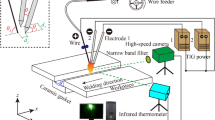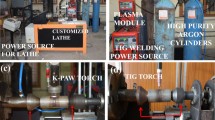Abstract
A novel pulsed metal active gas-tungsten inert gas (PMAG-TIG) twin-arc tandem welding process is applied to make stable back beads in the first layer weld during one-side multilayer welding without backing plate. The effect of different arc distances on the arc plasma behavior, molten pool flow pattern, and back appearance of root welding during the twin-arc tandem welding was studied. Results indicated that when arc distance is about 22 mm during the welding process, about 30% heat energy of the arc heat is utilized to melt the root face of base metal, and the rest heat energy acts on the molten pool. In this condition, the temperature distribution of the molten pool is appropriate, the flow of the front edge of the molten pool is suitable, the back appearance is continuous, stable, and uniform, and the back reinforcement and weld width is moderate. When arc distance is about 17 mm, more arc heat energy is utilized to melt the root face, the fluidity of the front edge of the molten pool is stronger, which leading to the back reinforcement is relatively larger. While arc distance is about 27 mm, less arc heat acts on the root face, the fluidity of the front edge of the weld pool is weak, resulting that in the back reinforcement is relatively small. This twin-arc tandem welding process is a new welding process giving high quality and efficiency in root welding for medium or thick plates.
Similar content being viewed by others
References
Yamane S, Yamamoto H, Ishihara T, Kubota T, Eguchi K, Oshima K (2004) Adaptive control of back bead in V groove welding without backing plate. Sci Technol Weld Join 9:138–148
Azar AS, Fostervoll H, Perillo G, Tveito KO (2015) Aerogel: an alternative weld backing material. Int J Adv Manuf Technol 81:585–595
Malin V (2001) Root weld formation in modified refractory flux one-sided welding: part 1-effect of welding variables. Weld J 80:217–226
Yang CD, Zhong JY, Chen YX, Chen HB, Lin T, Chen SB (2014) The realization of no back chipping for thick plate welding. Int J Adv Manuf Technol 74:79–88
Yamane S, Uji K, Nakajima T, Yamamoto H (2015) Application of switch back welding to V groove MAG welding. Weld Int 29:103–109
Yamane S, Yamamoto H, Kaneko Y, Oshima K (2006) Sensing and seam tracking of welding line in backingless V groove welding. Sci Technol Weld Join 11:586–592
Yamane S, Sharif LH, Zeniya S, Oshima K (2005) Feed forward control of back bead and bead height in narrow gap robotic welding. Sci Technol Weld Join 10:23–26
Yang CD, Zhang HJ, Zhong JY, Chen YX, Chen SB (2014) The effect of DSAW on preheating temperature in welding thick plate of high-strength low-alloy steel. Int J Adv Manuf Technol 71:421–428
Zhang HJ, Zhang GJ, Cai CB, Gao HM, Wu L (2008) Fundamental studies on in-process controlling angular distortion in asymmetrical double-sided double arc welding. J Mater Process Technol 205:214–223
Kah P, Suoranta R, Martikainen J (2013) Advanced gas metal arc welding processes. Int J Adv Manuf Technol 67:655–674
Park HJ, Kim DC, Kang MJ, Rhee S (2013) The arc phenomenon by the characteristic of EN ratio in AC pulse GMAW. Int J Adv Manuf Technol 66:867–875
Roepke C, Liu S, Kelly S, Martukanitz R (2010) Hybrid laser arc welding process evaluation on DH36 and EH36 steel. Weld J 89:140–149
Ma GH, Zhang YM (2012) A novel DE-GMAW method to weld steel tubes on simplified condition. Int J Adv Manuf Technol 63:147–153
Li KH, Zhang YM, Xu P, Yang FQ (2008) High-strength steel welding with consumable double-electrode gas metal arc welding. Weld J 87:57–64
Lu Y, Chen S, Shi Y, Li X, Chen J, Kvidahl L, Zhang YM (2014) Double-electrode arc welding process: principle, variants, control and developments. J Manuf Process 16:93–108
Wu CS, Hu ZH, Zhong LM (2012) Prevention of humping bead associated with high welding speed by double-electrode gas metal arc welding. Int J Adv Manuf Technol 63:573–581
Meng XM, Qin GL, Zhang YQ, Fu BL, Zou ZD (2014) High speed TIG–MAG hybrid arc welding of mild steel plate. J Mater Process Technol 214:2417–2424
Kanemaru S, Sasaki T, Sato T, Mishima H, Tashiro S, Tanaka M (2014) Study for TIG–MIG hybrid welding process. Weld World 58:11–18
Kanemaru S, Sasaki T, Sato T, Era T, Tanaka M (2015) Study for the mechanism of TIG-MIG hybrid welding process. Weld World 59:261–268
Ando K, Hasegawa M (1978) Welding arc phenomena. The Machine Industrial, Beijing
Wei HL, Li H, Yang LJ, Gao Y, Ding XP (2015) Arc characteristics and metal transfer process of hybrid laser double GMA welding. Int J Adv Manuf Technol 77:1019–1028
Wang HC, Hu SS, Wang ZJ, Xu QF (2016) Arc characteristics and metal transfer modes in arcing-wire gas tungsten arc welding. Int J Adv Manuf Technol 86:925–933
Qi BJ, Yang MX, Cong BQ, Liu FJ (2013) The effect of arc behavior on weld geometry by high-frequency pulse GTAW process with 0Cr18Ni9Ti stainless steel. Int J Adv Manuf Technol 66:1545–1553
Chen J, Zong R, Wu CS, Padhy GK, Hu QX (2017) Influence of low current auxiliary TIG arc on high speed TIG-MIG hybrid welding. J Mater Process Technol 243:131–142
Ueyama T, Ohnawa T, Tanaka M, Nakata K (2007) Occurrence of arc interaction in tandem pulsed gas metal arc welding. Sci Technol Weld Join 12:523–529
Ye DJ, Hua XM, Xu C, Li F, Wu YX (2017) Research on arc interference and welding operating point change of twin wire MIG welding. Int J Adv Manuf Technol 89:493–502
Miao YG, Xu XF, Wu BT, Li XX, Han DF (2014) Effects of bypass current on the stability of weld pool during double sided arc welding. J Mater Process Technol 214:1590–1596
Author information
Authors and Affiliations
Corresponding author
Ethics declarations
Conflict of interest
The authors declare that they have no conflict of interest.
Rights and permissions
About this article
Cite this article
Zhou, Y., Zhang, Z. & Liu, L. Effect of arc distance on back appearance of root welding without backing plate by PMAG-TIG twin-arc welding. Int J Adv Manuf Technol 92, 3583–3592 (2017). https://doi.org/10.1007/s00170-017-0393-z
Received:
Accepted:
Published:
Issue Date:
DOI: https://doi.org/10.1007/s00170-017-0393-z




